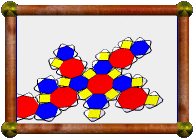


| Home > Research > Consistent Vertex Descriptions | |
| Next (Cut Equilateral Triangle In 6) | Next (Unsupportable Finite Cells) |
Consistent Vertex Descriptions |
From what I can tell, Great Stella is the first program to create the uniform polyhedra based on vertex descriptions, rather than Wythoff symbols. Wythoff symbols are not used at all by the program, and are shown for interest only. Wythoff symbols work for all but one of the uniform polyhedra, and also don't work for Skilling's figure (a not quite uniform polyhedron, also known as the great disnub dirhombidodecahedron). Vertex descriptions work for all uniform polyhedra and Skilling's figure (although Great Stella can not create Skilling's figure yet, but I'm working on it!). They are also more intuitive. It is much easier to look at a uniform solid and figure out what its vertex description is than its Wythoff symbol (or maybe that's just me!).
While writing this program though, I noticed that some of the vertex descriptions commonly given for some uniform polyhedra seemed to be wrong. There has been some debate about this between me and other folk, and much to my surprise, various big names in the polyhedron world still disagree with my versions of those vertex descriptions.
In 1993, Zvi Har'El gave vertex descriptions for all the uniform polyhedra in his paper "Uniform Solution for Uniform Polyhedra," (Geometriae Dedicata 47). For example, the great inverted retrosnub icosidodecahedron (or GIRI for short) had the vertex description "3.3/2.3.5/3.3". Seems now everyone agrees that this is incorrect. It was derived from a simple formula for converting the Wythoff symbol into a vertex description. The problem here is that the "3" is a triangle, and the following "3/2" would be a retrograde triangle, which would align exactly with the previous triangle. You'll find these vertex descriptions on various web sites too, which have inherited the problem from Zvi Har'El's paper.
Peter Messer later suggested a modified method for converting Wythoff symbols into vertex descriptions, but my argument is that this is still not quite right. The new vertex description for the GIRI is then "3/2.3/2.3/2.5/3.3/2". All the faces are retrograde here (the fractions are greater than 1/2), which doesn't make the faces wrap around the vertex twice as is required, but rather makes them wrap backwards around the vertex (but still only once).
Consider the following two vertex figures (from Great Stella, showing my version of the vertex descriptions).
 |
 |
| (3.3.3.3.3) / 2 | (5/2.3.3.3.3) / 2 |
They are very similar (topologically identical), and this should be reflected in their vertex descriptions. Sure the whole model looks very different, but we're only describing one vertex here. Both models are fully-supported, and there is nothing retrograde about the cycle of faces around the vertex. Each one continues in the same direction around the vertex as the previous one did. So I don't see why any faces should be given as retrograde in the vertex description.
Also, specifying all faces as retrograde does not magically make them surround the vertex twice. You need the "/ 2" at the end (some other people write this as "^ (1/2)", but this is just a matter of syntax). If you look at any model that has both non-retrograde and retrograde triangles in its vertex description (eg the tetrahemihexahedron, "3.4.3/2.4"), you will see that they both mark out the same angle around the vertex, but in opposite directions. So if all the faces are retrograde, the only effect would be that the faces would circle the vertex in the opposite direction (but still only once with a "/ 2" at the end), turning your model inside out.
There were only a few models that needed their vertex figures corrected, and then Great Stella could create those models correctly. Since this is the only program to use the vertex description alone in its calculations, they must be mathematically consistent with each other.
| Home > Research > Consistent Vertex Descriptions | |
| Next (Cut Equilateral Triangle In 6) | Next (Unsupportable Finite Cells) |